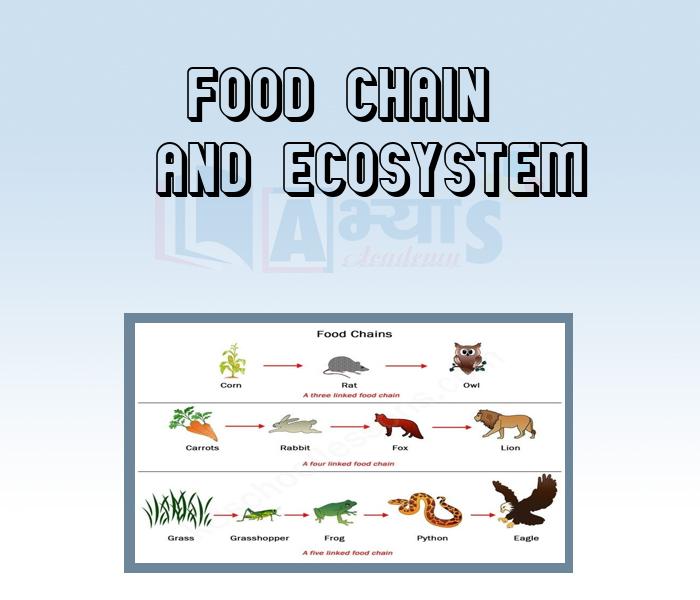Food Chain And Ecosystem












Food Chain And Ecosystem
Food Chain: Some or all of these trophic levels combine to form a food web/food chain, the ecosystem's mechanism for circulating and recycling energy and materials. A food chain represents a succession of organisms that eat another organism and are, in turn, eaten themselves. The number of steps an organism holds from the start of the chain is a measure of its trophic level. For example, in an aquatic ecosystem, algae and other aquatic plants use sunlight to produce energy in the form of carbohydrates. Primary consumers such as insects and small fish may feed on some of this plant matter, and are, in turn, eaten by secondary consumers, such as salmon. A brown bear may play the role of the tertiary consumer by catching and eating salmon. Bacteria and fungi may then feed upon and decompose the salmon carcass left behind by the bear, enabling the valuable non-living components of the ecosystem, such as chemical nutrients, to leach back into the soil and water, where they can be absorbed by the roots of plants. In this way, nutrients and the energy that green plants derive from sunlight are efficiently transferred and recycled throughout the ecosystem.
For example, one food chain may be represented as follows:
Sun Algae
Fish
Salmon
Brown Bear
(Energy) (Producer) (First-order consumer) (Second-order consumer) (Tertiary consumer)
(Autotroph) (Herbivore) (Carnivore) (Carnivore)
The number of steps in the food chain is limited to four or five. At each step in a food chain, a large portion of energy is used for its own maintenance, and then lost as heat. As a result, organisms in each trophic level pass on less and less energy than they receive. The longer the chain, the lesser is the energy available to the final member. In a simple food chain, out of say 1,000 calories of energy reaching the plant, only 10 calories (1%) are stored by plant. The remaining are lost either to the environment or to the plant for its own maintenance. Of the 10 calories available to the herbivore, nine are lost at its level and one is passed on to the carnivores.
Students / Parents Reviews [10]
My experience with Abhyas is very good. I have learnt many things here like vedic maths and reasoning also. Teachers here first take our doubts and then there are assignments to verify our weak points.

Shivam Rana
7thMy experience with Abhyas academy is very good. I did not think that my every subject coming here will be so strong. The main thing is that the online tests had made me learn here more things.

Hiya Gupta
8thAbhyas is a complete education Institute. Here extreme care is taken by teacher with the help of regular exam. Extra classes also conducted by the institute, if the student is weak.

Om Umang
10thI have spent a wonderful time in Abhyas academy. It has made my reasoning more apt, English more stronger and Maths an interesting subject for me. It has given me a habbit of self studying

Yatharthi Sharma
10thIt was good as the experience because as we had come here we had been improved in a such envirnment created here.Extra is taught which is beneficial for future.

Eshan Arora
8thIt has a great methodology. Students here can get analysis to their test quickly.We can learn easily through PPTs and the testing methods are good. We know that where we have to practice

Barkha Arora
10thAbout Abhyas metholodology the teachers are very nice and hardworking toward students.The Centre Head Mrs Anu Sethi is also a brilliant teacher.Abhyas has taught me how to overcome problems and has always taken my doubts and suppoeted me.

Shreya Shrivastava
8thOne of the best institutes to develope a child interest in studies.Provides SST and English knowledge also unlike other institutes. Teachers are co operative and friendly online tests andPPT develope practical knowledge also.

Aman Kumar Shrivastava
10thMy experience was very good with Abhyas academy. I am studying here from 6th class and I am satisfied by its results in my life. I improved a lot here ahead of school syllabus.

Ayan Ghosh
8thIt was a good experience with Abhyas Academy. I even faced problems in starting but slowly and steadily overcomed. Especially reasoning classes helped me a lot.
